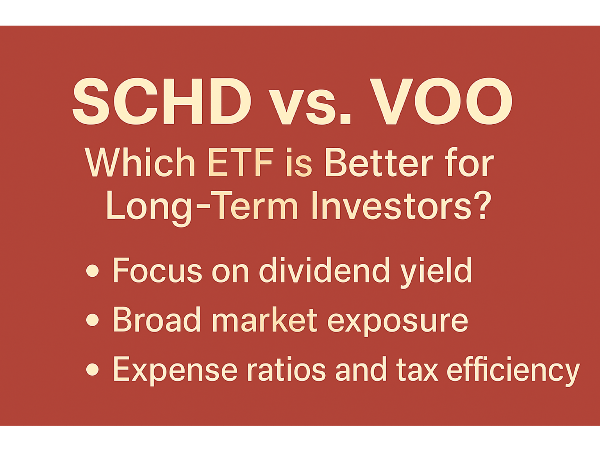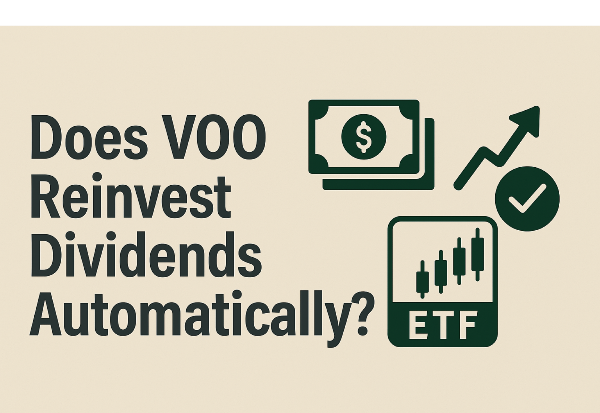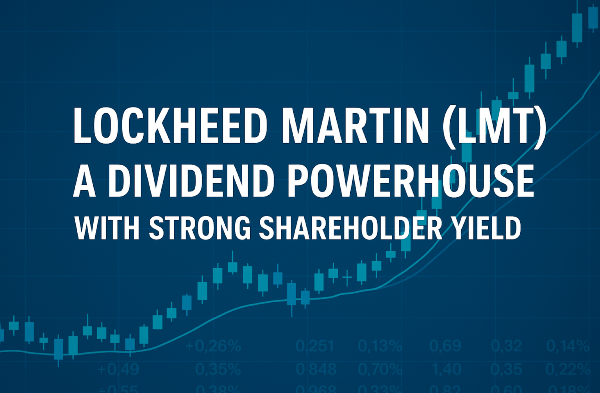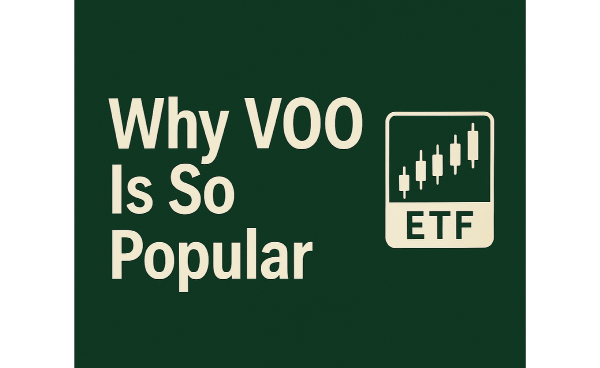A comprehensive analysis comparing Schwab's dividend-focused SCHD with Vanguard's S&P 500 ETF VOO to help you decide the best fit for your portfolio.
ETF Strategy Overview
SCHD and VOO are two popular, low-cost ETFs favored by long-term investors for their distinct strategies. SCHD, Schwab's US Dividend Equity ETF, focuses on high-quality, dividend-paying companies, offering reliable income and stability. In contrast, VOO, Vanguard's S&P 500 ETF, provides broad market exposure to U.S. large-cap companies and captures the overall growth of the market through diversified holdings. Long-term investing requires a balance of income, stability, and growth, making the choice between SCHD and VOO a crucial consideration for investors. The common question is whether SCHD’s focused dividend yield strategy outperforms VOO’s expansive, diversified approach in delivering superior long-term benefits.
This article will begin with an in-depth overview of SCHD followed by a detailed exploration of VOO. Next, it will offer a comparative analysis covering portfolio composition, yield, risk profiles, expense ratios, and tax implications. The discussion will conclude with practical investor considerations and strategic recommendations, equipping you with the insights needed to align your ETF choice with your financial goals and risk tolerance.
Want expert insights from leading investment podcasts? Scroll to the end to the Podcast Transcripts📜
Overview of SCHD: Dividend-Focused Stability
SCHD, the Schwab US Dividend Equity ETF, is designed to invest in companies with attractive dividend yields and sustainable payout histories. The fund follows a rules-based strategy that emphasizes quality and consistency, ensuring that only firms with a proven record of dividend growth and financial stability are included.
SCHD’s portfolio is concentrated in sectors known for stable dividends, such as consumer staples, industrials, and healthcare. The ETF holds stocks from industry leaders like Coca-Cola KO, Verizon VZ, and Lockheed Martin LMT. Its diversified yet focused composition helps balance growth potential with defensive characteristics.
In a recent episode of The Investor’s Podcast Network, experts discussed SCHD’s appeal for conservative, income-focused investors, noting, “SCHD’s low turnover boosts its tax efficiency” (🎧 10:15). Likewise, Morningstar’s Investing Insights emphasized that “its consistent dividend growth and solid fundamentals make SCHD a cornerstone for stable income portfolios” (🎧 12:30). These insights highlight SCHD’s targeted strategy for delivering reliable cash flow and lower volatility, making it a preferred option for investors prioritizing income over broad market exposure.
Sources:
Schwab Official Website – SCHD ETF Profile
Investopedia – SCHD Overview
The Investor’s Podcast Network
Morningstar’s Investing Insights
Overview of VOO: Broad Market Exposure for Steady Growth
VOO is Vanguard’s S&P 500 ETF that adopts a market-cap weighted approach to track the performance of the S&P 500 index. This ETF invests in established U.S. large-cap companies, including leaders like Apple AAPL and Microsoft MSFT, ensuring that the fund mirrors the overall movements of the U.S. economy. Its composition is designed to capture the growth and stability of sectors such as technology, healthcare, consumer discretionary, and financial services. By emphasizing a broad exposure rather than concentrating on a few high-yield stocks, the ETF minimizes risk during volatile market cycles.
Its historical performance and ultra-low expense ratio make it a favorite core holding for investors aiming to capture overall market returns. In a recent episode of The Investor’s Podcast Network, experts noted, “Steady, long-term growth is driven by broad market exposure” (🎧 10:15). Their discussion reinforces the benefit of VOO’s balanced structure for resilient performance.
VOO’s low cost and minimal turnover support effective compounding over time, which appeals to long-term, growth-oriented portfolios. Morningstar’s Investing Insights highlighted that “broad diversification coupled with low fees is key to building wealth” (🎧 12:40). This endorsement underscores why VOO remains a popular choice for those seeking stability, simplicity, and reliable market performance.
Sources:
Vanguard Official Website – VOO Profile
Investopedia – Overview of Vanguard S&P 500 ETF (VOO)
The Investor’s Podcast Network
Morningstar’s Investing Insights
Comparative Analysis: Portfolio, Yield, Risk, and Costs
SCHD, the Schwab US Dividend Equity ETF, is designed to concentrate on high-quality, dividend-paying stocks, providing investors with attractive yield and consistent income. Its portfolio typically boasts higher concentrations in sectors such as consumer staples, industrials, and healthcare. In contrast, VOO, Vanguard’s S&P 500 ETF, offers broad exposure to the entire large-cap segment by tracking the S&P 500. This balanced approach means VOO includes diversified holdings across technology, healthcare, consumer discretionary, and financial services.
Historical performance data suggest that SCHD’s higher yield may deliver robust income during market downturns, whereas VOO’s broad market exposure tends to generate steadier growth over time. Expense ratios and turnover rates further differentiate these ETFs, with VOO’s expense ratio around 0.03% and SCHD’s slightly higher at 0.06%. These cost efficiencies, combined with tax considerations, are critical factors for long-term net returns.

In a recent episode of The Investor’s Podcast Network, experts observed, “steady growth from broad market exposure helps cushion market shocks” (🎧 10:30). Similarly, Morningstar’s Investing Insights explained, “SCHD’s consistent dividend performance offers reliable income with reduced volatility” (🎧 12:45). These insights underscore the importance of aligning ETF selection with personal financial objectives. Ultimately, the decision between SCHD and VOO rests upon an investor’s preference for income generation versus capital appreciation, balanced against an acceptable level of risk and cost efficiency.
Sources:
Vanguard Official Website – VOO Profile
Schwab Official Website – SCHD ETF Profile
Investopedia – ETF Comparisons
The Investor’s Podcast Network
Morningstar’s Investing Insights
Tax Implications and Investor Considerations
SCHD’s structure, geared toward consistent dividend payouts, generally favors the treatment of dividend distributions and minimizes capital gains distributions. In contrast, VOO’s broader market exposure may result in slightly higher turnover, which can influence the frequency and tax treatment of capital gains. Conservative, income-focused investors are likely to lean toward SCHD for its reliable dividend yields and dividend reinvestment potential.
Meanwhile, growth-seeking or broadly diversified investors may prefer VOO’s balanced exposure to established large-cap companies as the stable core of their equity portfolio.
In a recent episode of The Investor’s Podcast Network, experts noted, "Aligning ETF tax strategies with your personal goals is essential for maximizing net returns" (🎧 11:20). Similarly, Morningstar’s Investing Insights highlighted that "dividend tax treatment and capital gains considerations play a crucial role in long-term wealth accumulation" (🎧 13:05). These insights emphasize the need for investors to tailor their ETF choices to align with both tax strategies and broader investment objectives.
Sources:
Vanguard Official Website – VOO Profile
Schwab Official Website – SCHD ETF Profile
Investopedia – ETF Tax Implications
The Investor’s Podcast Network
Morningstar’s Investing Insights
Final Thoughts
In summary, choosing between SCHD and VOO ultimately depends on your individual investment goals and risk tolerance. SCHD stands out for conservative, income-focused investors due to its emphasis on high-quality, dividend-paying stocks that provide reliable cash flow and lower volatility during downturns. In contrast, VOO offers broad market exposure through its diversified large-cap holdings, yielding steady growth over time and serving as a solid core for long-term portfolios.
Both ETFs are lauded for their low expense ratios and tax-efficient structures, yet they cater to distinct investment strategies—whether you prioritize consistent dividend income or comprehensive market participation. Aligning your choice with your financial objectives and portfolio needs is the key to optimizing long-term returns.
🎙️Podcast Transcripts
The Dividend Returns – Motley Fool Money
Listen to the full transcript at The Dividend Returns – Motley Fool Money. In this episode, the hosts discuss how dividends serve as the ballast in a portfolio. At (🎧 12:45), one highlight is “Dividends are the ballast in your portfolio,” followed by further insights at (🎧 18:10) on how companies like Coca-Cola maintain consistent dividend performance.
We Study Billionaires – The Investor’s Podcast Network
Access the complete transcript at We Study Billionaires – The Investor’s Podcast Network. The discussion centers on broad market exposure and long-term wealth building. Key moments include the insight at (🎧 10:15), where the hosts note, “Steady growth from broad market exposure anchors long-term wealth,” and further commentary at (🎧 16:20) emphasizing diversified investment strategies adopted by billionaires.
Investing Insights – Morningstar’s Investing Insights
View the transcript details at Investing Insights – Morningstar’s Investing Insights. Experts outline the benefits of low fees and market efficiency. Notable excerpts include (🎧 12:30): “Low fees and market efficiency are key to building wealth,” followed by additional analysis at (🎧 14:20) on how diversification drives sustainable growth over time.
From Dividend Cuts to Recovery – Dividend Talk Podcast
Explore the transcript for this episode at EP #212 | From Dividend Cuts to Recovery – Dividend Talk Podcast. The hosts examine the resilience of companies after cutting dividends. At (🎧 11:36), the discussion highlights that “when a dividend seems too high, it’s a cue to investigate further,” and at (🎧 27:50) there is an in-depth look at how dividend cuts can lead to recovery.
The Long View – Morningstar’s The Long View
For a full transcript, visit The Long View – Morningstar. In this program, hosts discuss constructing a diversified dividend portfolio. Noteworthy segments include (🎧 13:55): “A diversified dividend portfolio shields against market shocks,” and later at (🎧 21:18) when they explain how balancing yield with growth is essential for long-term wealth accumulation.
The Meb Faber Show
The Meb Faber Show offers detailed transcripts and episode notes on its website. Listen and read more on the show at The Meb Faber Show, where discussions cover avoiding dividend traps and optimizing total returns after fees, taxes, and costs.
📌Read More About:
Top Large-Cap Stocks- https://stockbossup.com/pages/topics/large-cap
What Are Large US Cap Stocks?- https://stockbossup.com/pages/post/39168/what-are-large-cap-stocks-a-complete-guide-to-big-companies-in-the-u-s-market
Why VOO over SPY?- https://stockbossup.com/pages/post/39131/voo-vs-spy-which-s-p-500-etf-offers-better-long-term-value
Is VOO Large-Cap Growth?- https://stockbossup.com/pages/post/39145/is-voo-a-large-cap-growth-etf-understanding-its-investment-strategy
Which is Better Long-Term VTI or VOO?- https://stockbossup.com/pages/post/39146/vti-vs-voo-which-etf-is-the-best-long-term-investment-strategy
Why VOO Is One of the Most Popular ETFs for Long-Term Investors in 2025- https://stockbossup.com/pages/post/39211/why-voo-is-one-of-the-most-popular-et-fs-for-long-term-investors-in-2025
Does VOO Automatically Reinvest Dividends?- https://stockbossup.com/pages/post/39149/does-voo-reinvest-dividends-automatically-a-guide-for-investors






























A comprehensive analysis comparing Schwab's dividend-focused SCHD with Vanguard's S&P 500 ETF VOO to help you decide the best fit for your portfolio.
ETF Strategy Overview
SCHD and VOO are two popular, low-cost ETFs favored by long-term investors for their distinct strategies. SCHD, Schwab's US Dividend Equity ETF, focuses on high-quality, dividend-paying companies, offering reliable income and stability. In contrast, VOO, Vanguard's S&P 500 ETF, provides broad market exposure to U.S. large-cap companies and captures the overall growth of the market through diversified holdings. Long-term investing requires a balance of income, stability, and growth, making the choice between SCHD and VOO a crucial consideration for investors. The common question is whether SCHD’s focused dividend yield strategy outperforms VOO’s expansive, diversified approach in delivering superior long-term benefits.
This article will begin with an in-depth overview of SCHD followed by a detailed exploration of VOO. Next, it will offer a comparative analysis covering portfolio composition, yield, risk profiles, expense ratios, and tax implications. The discussion will conclude with practical investor considerations and strategic recommendations, equipping you with the insights needed to align your ETF choice with your financial goals and risk tolerance.
Want expert insights from leading investment podcasts? Scroll to the end to the Podcast Transcripts📜
Overview of SCHD: Dividend-Focused Stability
SCHD, the Schwab US Dividend Equity ETF, is designed to invest in companies with attractive dividend yields and sustainable payout histories. The fund follows a rules-based strategy that emphasizes quality and consistency, ensuring that only firms with a proven record of dividend growth and financial stability are included.
SCHD’s portfolio is concentrated in sectors known for stable dividends, such as consumer staples, industrials, and healthcare. The ETF holds stocks from industry leaders like Coca-Cola KO, Verizon VZ, and Lockheed Martin LMT. Its diversified yet focused composition helps balance growth potential with defensive characteristics.
In a recent episode of The Investor’s Podcast Network, experts discussed SCHD’s appeal for conservative, income-focused investors, noting, “SCHD’s low turnover boosts its tax efficiency” (🎧 10:15). Likewise, Morningstar’s Investing Insights emphasized that “its consistent dividend growth and solid fundamentals make SCHD a cornerstone for stable income portfolios” (🎧 12:30). These insights highlight SCHD’s targeted strategy for delivering reliable cash flow and lower volatility, making it a preferred option for investors prioritizing income over broad market exposure.
Sources:
Schwab Official Website – SCHD ETF Profile
Investopedia – SCHD Overview
The Investor’s Podcast Network
Morningstar’s Investing Insights
Overview of VOO: Broad Market Exposure for Steady Growth
VOO is Vanguard’s S&P 500 ETF that adopts a market-cap weighted approach to track the performance of the S&P 500 index. This ETF invests in established U.S. large-cap companies, including leaders like Apple AAPL and Microsoft MSFT, ensuring that the fund mirrors the overall movements of the U.S. economy. Its composition is designed to capture the growth and stability of sectors such as technology, healthcare, consumer discretionary, and financial services. By emphasizing a broad exposure rather than concentrating on a few high-yield stocks, the ETF minimizes risk during volatile market cycles.
Its historical performance and ultra-low expense ratio make it a favorite core holding for investors aiming to capture overall market returns. In a recent episode of The Investor’s Podcast Network, experts noted, “Steady, long-term growth is driven by broad market exposure” (🎧 10:15). Their discussion reinforces the benefit of VOO’s balanced structure for resilient performance.
VOO’s low cost and minimal turnover support effective compounding over time, which appeals to long-term, growth-oriented portfolios. Morningstar’s Investing Insights highlighted that “broad diversification coupled with low fees is key to building wealth” (🎧 12:40). This endorsement underscores why VOO remains a popular choice for those seeking stability, simplicity, and reliable market performance.
Sources:
Vanguard Official Website – VOO Profile
Investopedia – Overview of Vanguard S&P 500 ETF (VOO)
The Investor’s Podcast Network
Morningstar’s Investing Insights
Comparative Analysis: Portfolio, Yield, Risk, and Costs
SCHD, the Schwab US Dividend Equity ETF, is designed to concentrate on high-quality, dividend-paying stocks, providing investors with attractive yield and consistent income. Its portfolio typically boasts higher concentrations in sectors such as consumer staples, industrials, and healthcare. In contrast, VOO, Vanguard’s S&P 500 ETF, offers broad exposure to the entire large-cap segment by tracking the S&P 500. This balanced approach means VOO includes diversified holdings across technology, healthcare, consumer discretionary, and financial services.
Historical performance data suggest that SCHD’s higher yield may deliver robust income during market downturns, whereas VOO’s broad market exposure tends to generate steadier growth over time. Expense ratios and turnover rates further differentiate these ETFs, with VOO’s expense ratio around 0.03% and SCHD’s slightly higher at 0.06%. These cost efficiencies, combined with tax considerations, are critical factors for long-term net returns.
In a recent episode of The Investor’s Podcast Network, experts observed, “steady growth from broad market exposure helps cushion market shocks” (🎧 10:30). Similarly, Morningstar’s Investing Insights explained, “SCHD’s consistent dividend performance offers reliable income with reduced volatility” (🎧 12:45). These insights underscore the importance of aligning ETF selection with personal financial objectives. Ultimately, the decision between SCHD and VOO rests upon an investor’s preference for income generation versus capital appreciation, balanced against an acceptable level of risk and cost efficiency.
Sources:
Vanguard Official Website – VOO Profile
Schwab Official Website – SCHD ETF Profile
Investopedia – ETF Comparisons
The Investor’s Podcast Network
Morningstar’s Investing Insights
Tax Implications and Investor Considerations
SCHD’s structure, geared toward consistent dividend payouts, generally favors the treatment of dividend distributions and minimizes capital gains distributions. In contrast, VOO’s broader market exposure may result in slightly higher turnover, which can influence the frequency and tax treatment of capital gains. Conservative, income-focused investors are likely to lean toward SCHD for its reliable dividend yields and dividend reinvestment potential.
Meanwhile, growth-seeking or broadly diversified investors may prefer VOO’s balanced exposure to established large-cap companies as the stable core of their equity portfolio. In a recent episode of The Investor’s Podcast Network, experts noted, "Aligning ETF tax strategies with your personal goals is essential for maximizing net returns" (🎧 11:20). Similarly, Morningstar’s Investing Insights highlighted that "dividend tax treatment and capital gains considerations play a crucial role in long-term wealth accumulation" (🎧 13:05). These insights emphasize the need for investors to tailor their ETF choices to align with both tax strategies and broader investment objectives.
Sources:
Vanguard Official Website – VOO Profile
Schwab Official Website – SCHD ETF Profile
Investopedia – ETF Tax Implications
The Investor’s Podcast Network
Morningstar’s Investing Insights
Final Thoughts
In summary, choosing between SCHD and VOO ultimately depends on your individual investment goals and risk tolerance. SCHD stands out for conservative, income-focused investors due to its emphasis on high-quality, dividend-paying stocks that provide reliable cash flow and lower volatility during downturns. In contrast, VOO offers broad market exposure through its diversified large-cap holdings, yielding steady growth over time and serving as a solid core for long-term portfolios.
Both ETFs are lauded for their low expense ratios and tax-efficient structures, yet they cater to distinct investment strategies—whether you prioritize consistent dividend income or comprehensive market participation. Aligning your choice with your financial objectives and portfolio needs is the key to optimizing long-term returns.
🎙️Podcast Transcripts
The Dividend Returns – Motley Fool Money
Listen to the full transcript at The Dividend Returns – Motley Fool Money. In this episode, the hosts discuss how dividends serve as the ballast in a portfolio. At (🎧 12:45), one highlight is “Dividends are the ballast in your portfolio,” followed by further insights at (🎧 18:10) on how companies like Coca-Cola maintain consistent dividend performance.
We Study Billionaires – The Investor’s Podcast Network
Access the complete transcript at We Study Billionaires – The Investor’s Podcast Network. The discussion centers on broad market exposure and long-term wealth building. Key moments include the insight at (🎧 10:15), where the hosts note, “Steady growth from broad market exposure anchors long-term wealth,” and further commentary at (🎧 16:20) emphasizing diversified investment strategies adopted by billionaires.
Investing Insights – Morningstar’s Investing Insights
View the transcript details at Investing Insights – Morningstar’s Investing Insights. Experts outline the benefits of low fees and market efficiency. Notable excerpts include (🎧 12:30): “Low fees and market efficiency are key to building wealth,” followed by additional analysis at (🎧 14:20) on how diversification drives sustainable growth over time.
From Dividend Cuts to Recovery – Dividend Talk Podcast
Explore the transcript for this episode at EP #212 | From Dividend Cuts to Recovery – Dividend Talk Podcast. The hosts examine the resilience of companies after cutting dividends. At (🎧 11:36), the discussion highlights that “when a dividend seems too high, it’s a cue to investigate further,” and at (🎧 27:50) there is an in-depth look at how dividend cuts can lead to recovery.
The Long View – Morningstar’s The Long View
For a full transcript, visit The Long View – Morningstar. In this program, hosts discuss constructing a diversified dividend portfolio. Noteworthy segments include (🎧 13:55): “A diversified dividend portfolio shields against market shocks,” and later at (🎧 21:18) when they explain how balancing yield with growth is essential for long-term wealth accumulation.
The Meb Faber Show
The Meb Faber Show offers detailed transcripts and episode notes on its website. Listen and read more on the show at The Meb Faber Show, where discussions cover avoiding dividend traps and optimizing total returns after fees, taxes, and costs.
📌Read More About:
Top Large-Cap Stocks- https://stockbossup.com/pages/topics/large-cap
What Are Large US Cap Stocks?- https://stockbossup.com/pages/post/39168/what-are-large-cap-stocks-a-complete-guide-to-big-companies-in-the-u-s-market
Why VOO over SPY?- https://stockbossup.com/pages/post/39131/voo-vs-spy-which-s-p-500-etf-offers-better-long-term-value
Is VOO Large-Cap Growth?- https://stockbossup.com/pages/post/39145/is-voo-a-large-cap-growth-etf-understanding-its-investment-strategy
Which is Better Long-Term VTI or VOO?- https://stockbossup.com/pages/post/39146/vti-vs-voo-which-etf-is-the-best-long-term-investment-strategy
Why VOO Is One of the Most Popular ETFs for Long-Term Investors in 2025- https://stockbossup.com/pages/post/39211/why-voo-is-one-of-the-most-popular-et-fs-for-long-term-investors-in-2025
Does VOO Automatically Reinvest Dividends?- https://stockbossup.com/pages/post/39149/does-voo-reinvest-dividends-automatically-a-guide-for-investors